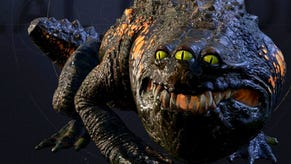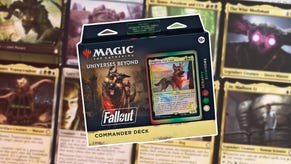Jet Set Willy, Trading Classiness for Freedom on Spectrum
The sequel to Manic Miner was quite a sophisticated game, but only in terms of its structure.
This article first appeared on USgamer, a partner publication of VG247. Some content, such as this article, has been migrated to VG247 for posterity after USgamer's closure - but it has not been edited or further vetted by the VG247 team.
After Pitfall! protagonist Pitfall Harry mastered the ins and outs of his first journey and became tremendously wealthy from all that gold he gathered from across the jungle, he went on to have an even grander adventure with his niece Rhonda and her pet wildcat Quickclaw in tow. In other words, Pitfall Harry sold out and went family-friendly in pursuit of even greater wealth and fame.
Over in the UK, however, Harry's equivalent was an adventurer by the name of Miner Willy, whose first outing -- Manic Miner for the Sinclair Spectrum microcomputer -- proved to be a Pitfall!-sized hit within that market. Like Harry, Willy became fabulously rich from his debut adventure. But rather than going all Disney on his fans, Willy's second adventure saw him wallowing in the depths of new-money decadence. Rather than set out to be a role model for his younger relatives, Willy appeared on his sequel's box art hunkered over a toilet, clearly emptying the contents of his stomach into the porcelain bowl even as he clutched a bottle of champagne. His sprite may have traded in a hardhat for a porkpie, but Willy remained anything but upper crust.

I know, America, I know. You hear "Great Britain" and think of posh things like elaborate royal weddings, Downton Abbey, and time-travelers wearing funny bow ties. But it turns out that technicolor yawns following a night of hard partying are an integral part of English life as well, and Jet Set Willy gleefully embraces its protagonist's blue-collar nature (the guy was a miner, after all) by giving what is probably a pretty realistic take on how a workaday joe who stumbled into unbelievable wealth would follow things up: By buying a home too large for himself, wrecking it with extravagant parties, and finding himself hungover the next day. Think Jesse Pinkman minus the existential despair.
Jet Set Willy saw the hapless ex-miner forced to shuffle through his enormous new home cleaning up after his friends' excesses of the previous night. You'd think that might be his housekeeper's job, but she's actually the one who instigates the whole adventure, refusing to let Willy retire to his bedroom until he's tidied up after himself. Lord Grantham would never accept such demands, but, well, that's the nouveau-riche for you. Spineless.
Complicating matters was the fact that Willy evidently purchased his new home sight unseen, and it contained countless rooms he'd never visited -- all of which, for some reason, were horrifyingly haunted by all manner of bizarre apparitions. These included gigantic demon faces, chainsaws buzzing along through the floorboards, outsized spiders, and more. And in that regard, at least, Willy didn't differ too much from his classier Yankee counterpart Harry: One hit from any of these creatures and he was a goner.

Unlike the methodical Pitfall series, however, Jet Set Willy was fast-paced, relentless, and distressing. Everything moved at an insane clip, and each screen of the mansion packed an enormous amount of content -- countless platforms and other climbable bits of scenery, and sometimes more than half a dozen creatures zipping along their own predetermined paths. It was fiendishly difficult.
Admittedly, it came about some of that difficulty in a less-than-sporting fashion. Even discounting the game-breaking bugs with which the adventure originally shipped (corrected via code updates distributed by the creators -- perhaps the industry's first example of "we'll fix it in the patch"), Jet Set Willy had a tendency to play unfair. The hero could shuffle between rooms from practically any point at the edge of a screen, often including the top and bottom edges, and it was all too easy to make a transition into another room in a fatal position (due to monsters, pits, or other hazards) and quickly burn through your stock of lives. There was a lot of guesswork involved in mastering the game, which wasn't really helped by untelegraphed death traps like the arrows that flew in from off-screen while exploring the roof.
On the other hand, it's hard to be too critical of the game considering just how preposterously ambitious it was. Though considerably smaller in terms of actual real estate than Pitfall II, Jet Set Willy was far more elaborate -- not to mention varied. Despite beginning life on the ZX Spectrum, a system with severely limited graphical capabilities, Jet Set Willy managed to present players with a fanciful but actually somewhat sensibly laid out mansion, with logical relative placement for its rooms. High above Willy's bedroom was the attic, above which you could scamper across the roof; to the east was a garden dominated by an enormous tree, while the western side of the mansion featured a dock complete with a small explorable yacht. Despite the abstraction imposed by the Spectrum's rudimentary visuals, Willy's home managed to be quite evocative.
It helped that each locale in the building was labeled; each screen of the adventure included its own name. Some of these simply explained where you were ("The Forgotten Abbey"), while others were simply meant to be amusing ("Dr Jones will never believe this," where the scenery roughly resembled a giant pink snake). And then you had more enigmatic locales, like the "Nightmare Room" in which Willy inexplicably transformed into a strange winged rat while being haunted by clones of his maid.
Many elements of Jet Set Willy would resurface in many other games throughout the years -- for instance, the Castlevania series' commitment to creating somewhat logical architectural connections within its settings -- but the game was much more directly influential than that. Microcomputer-based platformer action games for years to come used Jet Set Willy as their template, sending players running through non-linear deathtraps and not always being particularly fair about it. But try as they might, few could top the original.... if for no other reason than the fact that the game's ending brought that crass box art to life, with Willy dashing urgently from his bedroom to the nearest toilet. Victory comes in many forms, it seems.









